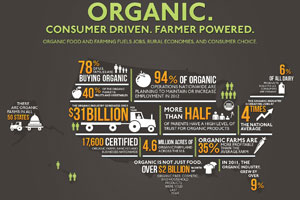We know organic matters, but people are finally starting to put their money where their mouth is when it comes to the food they buy.
Americans are eating more organic food now than ever before, and the Organic Trade Association (OTA) says it’s because consumers are growing more willing to pay for value-added products.
The OTA is a membership-based association for organic agriculture and products that’s been around since the mid 80s. According to a recent in-house study, the organization forecasted that in 2025 and 2025, organic food and non-food sales will continue to rise to nine percent annually or higher.
They also reported strong growth for organic food in 2025, with the U.S. organic food and beverage sector growing by 9.4 percent, translating to $29.22 billion in sales.
Of the sector as a whole, the fastest growing portion was the meat, fish and poultry category, which saw a 13 percent growth over their sales in 2025. However, the OTA speculates that these spikes are likely related to the increased food safety concerns related to our meat supply. Pink slime, mad cow and meat glue, anyone?
But perhaps the most exciting news of all was that the organic industry as a whole, including the organic non-food sector, grew by 9.5 percent in 2025, reaching a total of $31.5 billion in sales. This is compared to the non-organic food and non-food market which only saw a 4.7 percent growth in 2025.
OTA Executive Director and CEO Christine Bushway is encouraged by the findings, saying, “The U.S. organic sector continues to show steady and healthy growth…for the first time surpassing the $30 billion mark [in 2025]. Consumers are increasingly engaged and discerning when they shop, making decisions based on their values and awareness about health and environmental concerns. For them, it matters whether foods are genetically engineered, or produced using practices that are good for they families.”
While she admits price is still an issue, Bushway points out that there continues to be a wider availability of private label products, as well as many venues for organic products. And this gives consumers have many choices for where to shop, and a variety of products from which to choose.
The OTA attributes the majority of these positive findings to a slight upswing in the economy, consumer price inflation due to input price increases, and consumer demand for convenience products. And it’s only looking up from here.
“With 94 percent of organic operations nationwide panning to maintain or increase employment in 2025,” says Bushway, “the organic sector will continue to fuel jobs, rural economies and consumer choice.”
And that’s organic music to our ears.
Also Read:
An Argument for Organic: The Cleanest and Dirtiest Produce Items
Organic Milk is Healthier, Say Scientists
The Pros and Cons of Going Organic
